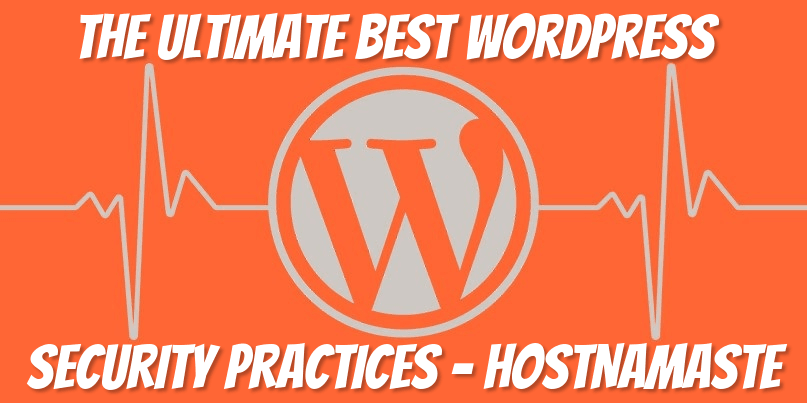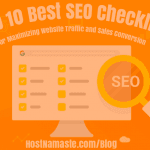|
Getting your Trinity Audio player ready...
|

The Ultimate Best WordPress Security Practices for 2024 – HostNamaste.com
WordPress site owners must adopt best security practices, because security lapses and glitches can negatively impact the reputation of their brand. WordPress powers more than 35% of sites online. Also, there are thousands of plugins and themes designed by third-party developers, which allow for adding new page elements, and also for simplifying many tasks.
However, the chances that vulnerability does still exist, even though they are discovered continuously, and patched up as soon as possible by the proactive WP community.
WordPress security is all about identifying and eliminating or reducing the potential risks. Using outdated WordPress, nulled plugins, poor credential management, incompetent system administration, and insufficient web security knowledge, are some of the main reasons for website security compromise.
This is where the hackers will looks to exploit the situation. Even the industry leaders, who neglected the best WP security practices, got hacked. Fortunately, website owners can take several steps to make their websites safe against security breaches. Below are some valuable WordPress Security Practices that can help you fortify your website from external attacks.
Keep your WP updated
WordPress is an open-source platform, which gets maintained regularly. Minor updates get installed automatically, by default. For major updates, you will need to initiate the updates manually. Even third-party themes and plugins developers release updates regularly. WP updates are crucial for the stability and security of your website or blog.
Enable SSL and HTTPS
Secure Socket Layer or SSL is an encryption protocol. Data that is transferred across the internet gets encrypted. Encryption makes it real hard for hackers to steal information. Enable SSL and your website will start employing HTTPS rather than HTTP. A padlock sign will be seen in the browser beside your site address. Make sure to get an SSL certificate to strengthen your website security.
Install WAF or Web Application Firewall
WAF allows you to feel relaxed about your WP site’s security. It is a firewall that blocks malicious traffic before it raids your website. A firewall works on two levels – DNS and application.
In the former, your site traffic gets routed via cloudy proxy servers, and only genuine traffic is sent to your server. In the latter, the traffic gets examined as soon as it reaches your web server. In comparison, the DNS level firewall efficiently reduces the server load.
Tighten Database Security
The first step for you to follow is to create an obscure and intelligent database names. If the name of your website is dog treats, then your WordPress database will possibly be named wp_dogtreats – by default. Changing this will make it hard for hackers to detect and gain access to your database information.
Alter the Database Prefix
Another option is to change the prefix of the database table. WordPress makes use of prefix ‘wp’ for every table in its database – by default. Hackers can easily guess the table name, so you must alter it to enhance your site security. However, you will need to know at least a little coding skill to do it.
Hide WordPress Version
The WordPress version gets revealed in the source code’s header – by default. Outdated WordPress installation is a tempting sign for intruders, as it is easier to hack into. Use a plugin that helps to conceal the WP version in a click. It is also crucial to keep your WordPress installation updated to lessen the security risk.
Install WP Security Plugins and keep them Updated
There are many developers that offer solid security solutions to your WordPress website. Some of the features in security plugins are –
- Generate strong passwords while creating user profiles
- User action log in
- Regularly force password expiry and reset
- Malware scanning
- WP security keys updates
- WP security firewalls
- Track DNS changes
- 2-step authentication
- Captchas
- Block malicious networks
- And more
- great practice to lock bad guys out! We recommend to install Wordfence Security – Firewall & Malware Scan
Two-step Authentication
- It is a great security technique, where the users will use two-step authentication to log in.
- Authenticate using username & password
- Validate using a separate device or an app
- Install an authentication app to reinforce your site security.
Secure wp-config.php
Wp-config.php file security is very important, as it is the core of your WordPress site. It holds all the information associated with security keys and database login that deals with encryption.
The wp-config.php is housed in the root directory – by default. Move it in a different file via copy/paste. The second step is to create new WordPress keys regularly. Root directory files carry a 644 code, which means the owner can read and write the files, while users in the owner’s group can read them. Set the permission of the file to 400 or 440 to avoid other server users from reading it.
Inactivate Directory Indexing & Browsing
Hackers use directory browsing to find vulnerable files and gain access. Other people also use directory browsing to identify your directory structure or copy images or gain access to other information. Disable the directory indexing & browsing for extra safety.
Protect your WordPress Admin Access
Obscure WordPress security might work okay for an average WP site. If backdoors are plugged, then the chances of getting attacked will reduce. Locking down WordPress admin access is a great strategy to escalate your security. Your wp-admin login URL has a default setting, which every hacker and bots are aware of. Changing the URL will offer better protection against the brutal force attack.
Limit the Number of Failed Login Attempts
WordPress allows limitless logins – by default. It leaves the site exposed to severe force attacks from hackers, who attempt to login using different combinations for cracking your password. You can limit failed login attempts for extra safety.
Deactivate XML-RPC
Brutal force attacks have been increasing largely on XML-RPC, in the last couple of years. XML-RPC has hidden features that allow your system’s multi-call method to actively implement multiple tasks in a single request. It is helpful because multiple commands can be passed inside a single HTTP request. However, even malicious minded people can also use it, so disable it!
Use Up-to-date PHP Version
Your server needs to use the up-to-date PHP version, because it is the pillar of your WP site. Every PHP major updates get full two years of support, after release. Within this time security and bug dilemmas get patched or fixed regularly.
It is studied that more than 76% of WP users are still using the old PHP versions, which are not supported. Therefore check the PHP version your server is using currently. Running on the old version can just make your site exposed to hackers, and it even impacts its performance.
Add updated HTTP Security Headers
HTTP security headers are designed for working at the server level. They tell a browser how to behave while dealing with the content on your website. Many security headers are available. The most crucial ones are –
- Strict-Transport-Security
- Public-Key-Pins
- Content-Security Policy
- X-Frame-Options
- X-XSS-Protection
- X-Content-Type
Check the kind of security headers your WordPress site currently has. You can even request your host to implement them!
Use Secure Connections
Make sure that your host offers SSH or SFTP connections. Secure File Transfer Protocol [SFTP] is a network code designed for file transfers in a more secure manner. SFTP is more secure than regular FTP. Your home-based router must also be set up correctly.
Someone hacking your home-based router can easily gain access to every kind of information along with crucial files stored on your WP site. Some simple tips –
- Disable VPN or remote management to avoid your network from getting exposed to the external world.
- By default – routers employ IPs in a range like 192.178.1.1. Use different ranges like 10.8.6.9.
- Your Wi-Fi must be capable of offering the highest encryption level.
- An IP white-list Wi-Fi allows access to certain IP addresses and people with a password.
- The firmware of your Wi-Fi needs to be kept updated.
- Never login your website in public locations.
Log out Inactive Users Automatically
Sometimes users, who log in can suddenly wander away from the screen, which is a great security risk. Anyone can change passwords or hijack their session. Financial and banking sites are at great vulnerability in such circumstances, so it is crucial to log out inactive users. Just install a relevant WordPress plugin and configure the time and log out message.
Add Captchas on the Login Page
Captchas protect your sensitive information. You can restrict access to important features on your site, and blocks attacks & spams. Captchas are not ultimate for site security but are a part of a full-fledged security program. They help to enhance site safety as well as users’ experience.
Prevent SQL Injection
Attackers inject malicious instructions into your SQL statement on the server-side. SQL injection on vulnerable sites allows the hacker to add, edit, delete or read database details. They can even read source code on a database server.
Actually, the scripting language on the server-side cannot determine the distortion of the SQL query. The best way to avoid SQL injection damage is to limit access, and to separate databases according to the purposes.
Secure the Content Delivery Network (CDN)
CDN is an overlay network, which moves the content of your website towards the end-user. Overlay network vendors allow site owners to use 3rd party infrastructure to enhance performance and security.
As the CDN infrastructure is shared, more security challenges in the clouds get created. Therefore secure your CDN account via setting IP address access rules, 2-factor authentication, and alerts. We recommend CloudFlare.
DDoS Protection
Denial of Service [DoS] attack is an old hacking technique that does not damage your website, but forces it to shut down for some hours or days. DDoS is a kind of DoS outbreak, where many systems are employed to target one-system.
An online business needs to protect its WP site from such DDoS attacks, because the ICMP and UDP protocols get targeted. It even helps to place your site behind a proxy, so that your specific IP address is hidden.
WordPress Scanning for Malware & Susceptibilities
A WordPress security plugin routinely scans for malware and possible security breaches. So, have it installed! However, whenever there is a decrease in traffic or dropping in your search ranks, it becomes necessary to perform a manual scanning.
Online scans are simple, you just need to enter site URL and your website gets thoroughly scanned for the known malware or malevolent codes. The scanners can only identify malware of susceptibilities, but are unable to eliminate malware or clean the malicious codes.
Clean Malicious Codes
Website security is crucial but even backups are essential. Therefore before you take steps to fix the hacked malicious codes have a backup. It is wise to be well-prepared before something worse strikes.
Hacked WordPress site fixes can be challenging and time-consuming, so engage a professional for the task. On affected sites, hackers installed backdoors will require proper fixing, otherwise your site can possibly get hacked once again.
WordPress Backups Solutions
Industry leaders feel confident about their best security practices, so they overlook backups. Remember, hackers, are a step ahead of all the introduced security programs. Therefore a website will never be totally safe. Therefore have a backup solution for handling the worst situations.
Many web hosts offer a variety of backups like automated backups. If your host provider has no backup solution, then there are plugins that can be used. In worst-case scenarios, your site gets restored with a few clicks!
Choose the right Web Hosting Provider
- Good hosting services take precautionary measures to defend their servers against the common risks.
- Constant monitoring of their network
- Special tools are installed to avoid DDoS attacks on a large scale.
- Server hardware and software are kept updated to fortify their security.
- They already have a disaster recovery plan, which helps to recover your data during major accident occurrence.
If you choose a shared hosting package, then the server resources get shared with other sites. It increases the threat of cross-site contamination. It means the hacker can use your neighboring site to gain access and attack your site.
Choose a managed hosting plan to gain advanced security configurations, automatic updates and backup solutions needed to secure your WordPress website. Qualities of a Good Web Host.
Conclusion
There are multiple ways to fortify your WordPress site security. Keep WordPress installation, themes and plugins updated, use clever passwords, take WP backups always, add captchas on the log in page, take steps to protect against brutal force attacks, and choose secure WordPress host for safe and better performance.
WordPress websites are the platform for generating incomes and promoting businesses, so it is crucial to employ the best WordPress security practices as soon as possible.





12 Replies to “The Ultimate Best WordPress Security Practices for 2024 – HostNamaste.com”